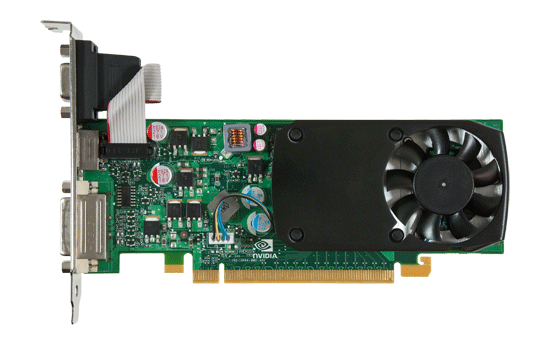NVIDIA Quietly Outs 40nm, DX10.1 Desktop Parts
Although the cards haven’t officially been launched, NVIDIA has published the specs and details of their 40nm-based desktop GPUs.
The cards in question are the GeForce GT 220 (codenamed GT216) and GeForce G210 (codenamed GT218) low-end, low-profile cards, both of which are OEM parts built on TSMC’s 40nm process – the same process that TSMC now seems to have sorted out.
The cards are DirectX 10.1 compliant and feature NVIDIA’s latest PureVideo HD engine. PhysX and CUDA are only available on the GeForce GT220. Targeted at the OEM market, these parts will make it into affordable pre-built systems as well as business-class machines.
As graphics cards go, the GT 220 and 210 cards won't compete in terms of 3D performance with the company’s more powerful GPUs, despite the generational process advantage.
The GT220 (pictured below), however, raises a few eyebrows as it has a 128-bit memory interface and 48 processor cores on a low profile PCB. As OEM cards usually get cut down to 64-bit memory interfaces the option to go 128-bit will give system builders an unusual amount of firepower for low-end systems. It features native HDMI but no Displayport. Considering the specs, we wouldn’t be surprised if we walked into an office and saw someone playing Fallout 3 on this one. Performance-wise you're looking at something between a 9500GT and a 9600GT most likely.
The G210 (pictured below) is more reserved and will do little else other than get Vista / 7’s Aero interface going with all the bells and whistles and some very casual gaming--think along the lines of the Sims. The 512MB of DDR2 and a 64-bit memory interface will severely restrict the performance on this card, no matter how many processor cores are available (16, by the way). On the other hand integrators should eventually be able to get this card running silently with a good passive cooler. The GeForce G210 features a DisplayPort output, VGA and DVI (HDMI 1.3a through an adapter), which matches it to AMD's lower-end 4300-series graphics cards.
One thing you won’t find on either card is SLI. Although the GT 220 was rumored to support it, the card lacks the fingers to connect a SLI bridge. Although SLI may be supported through the PCIe interface, like some older cards. No power connectors either, so these cards draw all the power they need from their PCIe x16 interface.
You can see the full spec list below.
The cards in question are the GeForce GT 220 (codenamed GT216) and GeForce G210 (codenamed GT218) low-end, low-profile cards, both of which are OEM parts built on TSMC’s 40nm process – the same process that TSMC now seems to have sorted out.
The cards are DirectX 10.1 compliant and feature NVIDIA’s latest PureVideo HD engine. PhysX and CUDA are only available on the GeForce GT220. Targeted at the OEM market, these parts will make it into affordable pre-built systems as well as business-class machines.
As graphics cards go, the GT 220 and 210 cards won't compete in terms of 3D performance with the company’s more powerful GPUs, despite the generational process advantage.
The GT220 (pictured below), however, raises a few eyebrows as it has a 128-bit memory interface and 48 processor cores on a low profile PCB. As OEM cards usually get cut down to 64-bit memory interfaces the option to go 128-bit will give system builders an unusual amount of firepower for low-end systems. It features native HDMI but no Displayport. Considering the specs, we wouldn’t be surprised if we walked into an office and saw someone playing Fallout 3 on this one. Performance-wise you're looking at something between a 9500GT and a 9600GT most likely.

The G210 (pictured below) is more reserved and will do little else other than get Vista / 7’s Aero interface going with all the bells and whistles and some very casual gaming--think along the lines of the Sims. The 512MB of DDR2 and a 64-bit memory interface will severely restrict the performance on this card, no matter how many processor cores are available (16, by the way). On the other hand integrators should eventually be able to get this card running silently with a good passive cooler. The GeForce G210 features a DisplayPort output, VGA and DVI (HDMI 1.3a through an adapter), which matches it to AMD's lower-end 4300-series graphics cards.

One thing you won’t find on either card is SLI. Although the GT 220 was rumored to support it, the card lacks the fingers to connect a SLI bridge. Although SLI may be supported through the PCIe interface, like some older cards. No power connectors either, so these cards draw all the power they need from their PCIe x16 interface.
You can see the full spec list below.


